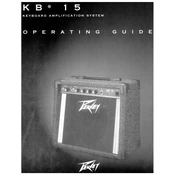Peavey KB 15 Operating Guide


To connect your keyboard to the Peavey KB 15 Amplifier, use a standard 1/4-inch instrument cable. Connect one end to the keyboard's output jack and the other end to the input jack on the amplifier.
First, check if the power cable is securely plugged into both the amplifier and the power outlet. Then, ensure that the power switch is in the 'on' position. If the amplifier still does not turn on, check the fuse and replace it if necessary.
Unwanted noise can often be reduced by ensuring all cables are properly shielded and in good condition. Also, avoid running audio cables parallel to power cables, and use a power conditioner if necessary.
Use a soft, dry cloth to wipe down the exterior of the amplifier regularly. Avoid using harsh chemicals. Ensure that the ventilation openings are free from dust and debris to maintain airflow.
Start by setting all EQ knobs to the neutral position (12 o'clock). Adjust the bass, mid, and treble controls to suit your preference and the acoustics of the room. Ensure that the volume is set to a comfortable level without distortion.
Check if the instrument and amplifier are powered on. Verify that the instrument cable is securely connected. Test with a different cable or instrument to rule out cable or source issues.
Yes, the Peavey KB 15 Amplifier can be used with various instruments such as electric guitars, basses, and electronic drum kits, as long as they have compatible output connections.
Check if the volume or gain is set too high, causing clipping. Ensure that all connections are secure and clean. Test the amplifier with a different instrument or cable to isolate the issue.
Regular maintenance should be performed every 6 months, including cleaning the exterior and checking for any loose connections or signs of wear. Professional servicing is recommended annually.
The Peavey KB 15 Amplifier should be connected to a stable AC power source with the voltage matching the specifications listed in the user manual. Using a surge protector is recommended to prevent damage from power surges.